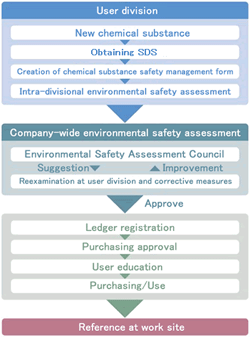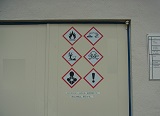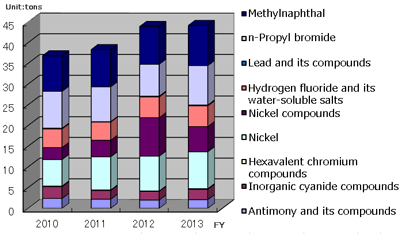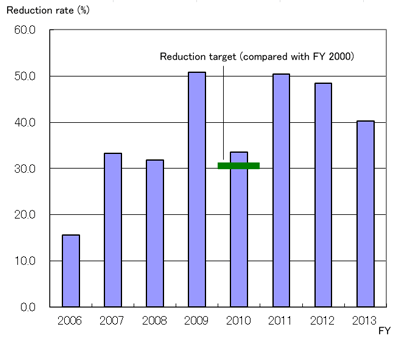Environmental Report 2014
Chemical Substance Management
The introduction of a new chemical substance or piece of equipment, construction work, increased waste volume, and other changes requires an environmental safety assessment under JAE's in-house pre-assessment system as shown in the flowchart below. For chemical substances, it has prepared an ad hoc chemical substance safety management form for the entry of requisite information on items including transport, storage, handling, and disposal. New chemical substances in particular can only be purchased if they pass this assessment. The pre-assessment flow for new chemical substances is shown below. The number of chemical substances registered in 2013 was on par with that of the previous year. However, as it has been increasing in recent years, the company will actively implement cuts in chemical substances that are no longer needed.■Pre-assessment flowchart for new chemical substances

■Change in the number of chemical substances

*Note: The number of chemical substances registered is greater than the actual number of chemical substances used because the same chemical substances may be registered on a per usage basis.

In fiscal 2013, the following were implemented.
(1) Improved operations to promote the renewal of SDS
JAE is improving its use of SDS, which record information on the hazardous nature of chemical substances at JAE sites, by enhancing rules on regularly collecting information and by maintaining its management of chemical substances.
(2) Expanding utilization of GHS
At JAE sites, GHS are displayed at the entrances to chemical storage areas and other locations. JAE will continue to work to convey information on hazards and toxic materials, even to those who do not work in such areas.
Reduction of Chemical Substances
As in the previous fiscal year, in fiscal 2013 each production site selected specific chemicals and worked to reduce the amount used in order to reduce its environmental impact. The main points of the activities for reducing the use of chemicals in fiscal 2013 are shown below, and these reduction efforts will continue in the coming years.・ Reduction of the metal used for deposition in gold plating (JAE)
・ Reduction of the amount of chemicals used by revising facility introduction and production processes, and by cutting back on the amount purchased (HAE, YAE)
・ Total elimination of carbon dioxide gas for cooling by switching testing method (SAE)
・ Reduction in the amount of VOC-emissions by improving the airtightness of containers, improving cleaning methods, and making production processes more efficient (JAE)
Note that the letters in parentheses, such as JAE, are abbreviations denoting sites that carried out the activities.
PRTR Data
The graph below shows the change in the amount of chemicals subject to the PRTR Law that was used by five domestic manufacturing companies.
In fiscal 2013, it became apparent that there was an increased volume of 1-bromopropane, which was the result of higher production volume. Reducing the amount of waste is also key to dealing with substances subject to PRTRs, and along with promoting recycling, the JAE Group is working hard to identify trends.

VOC Information
The JAE Group has been reducing VOC-related chemical emissions each year, primarily for acetone and isopropyl alcohol. In response to the Japanese government’s 30% reduction target for fiscal 2010, JAE sites had a reduction rate of 34%, meeting the Group’s target. Monitoring has continued since fiscal 2011, and for fiscal 2013, the reduction rate was 40.3%.
